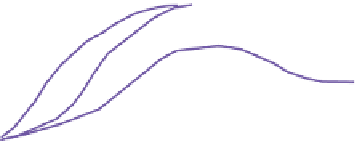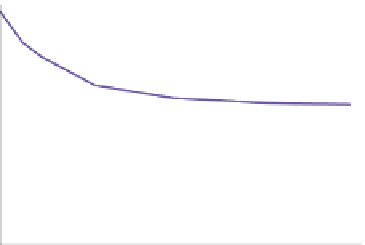Environmental Engineering Reference
In-Depth Information
chemical content. Even in streams, the movement of water interacts with the subsurface
sediment in so-called hyporheic flow (
Fisher and Welter 2005
), or with debris dams in
which some nutrient cycling processes are concentrated (
Montgomery 2008
). Burrowing in
intertidal flats and shallow coastal habitats are examples of patch dynamics, and examples
have been mentioned earlier in this chapter (
Godbold et al. 2011
).
The key insight of patch dynamics is that the spatial pattern of heterogeneity need not
be constant through time. Therefore, the spatial heterogeneity of ecological systems can
change as a result of changes within patches, or changes in surrounding patches. Entire
mosaics of ecological patches, such as the fire mosaic in boreal forests (
Figure 10.4
) or the
channel and sediment mosaics of alluvial floodplains, can change through time, with sig-
nificant implications for ecosystem functioning and the fluxes between ecosystems. How
temporal heterogeneity is generated and controlled is discussed in the following.
Causes and Trends of Temporal Heterogeneity
There are many potential causes of temporal heterogeneity. It may appear as a result of
disturbance, animal movement and activity, or the vegetation dynamics of succession
(
Pickett et al. 2000
). For example, following disturbance, new plant species may invade or
rise to dominance, and many abiotic features of the environment of an ecosystem may
change as a result (
Vitousek 2004
). Consequently, the demand for and availability of light,
nutrients, and water are all also subject to change. Primary productivity, respiration, litter
production, and litter quality also differ through time as a result of the changes in
resources and regulating factors altered by disturbance and succession. Its place in a suc-
cessional sequence will determine many aspects of an ecosystem's material and energy
budgets. In moist habitats, such successional differences can appear on new geological
substrates over centuries to a few thousand years (
Figure 10.10
). In situations where
Original P
Occluded P
Soil organic P
Plant P
Time
FIGURE 10.10
Generalized trends in phosphorus (P), a limiting nutrient over primary successions spanning
millions of years. The total amount of P, an element with a geologic rather than a gaseous source (see Chapter 8),
declines in the system over time. Labile P available to plants is a small and declining fraction of the total. Plant
content is always low compared to insoluble or occluded P and that bound in soil organic matter is low, but
peaks in middle ranges of the long succession. Trends redrawn from
Vitousek (2004)
, who confirmed the applica-
bility of this model to ancient volcanic succession across the Hawaiian Islands.





